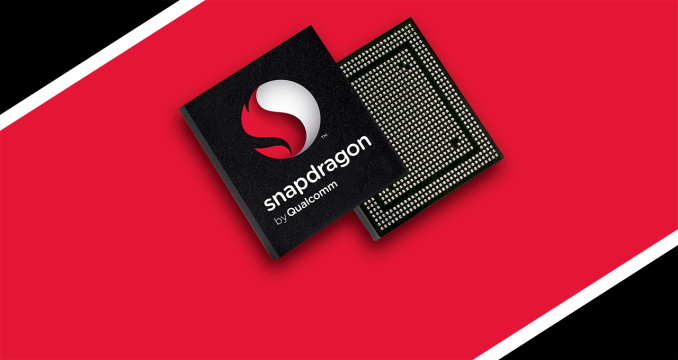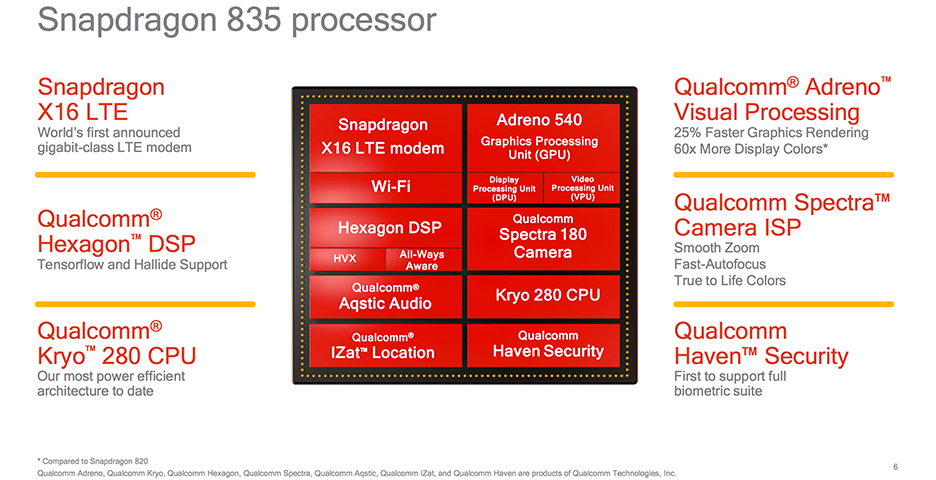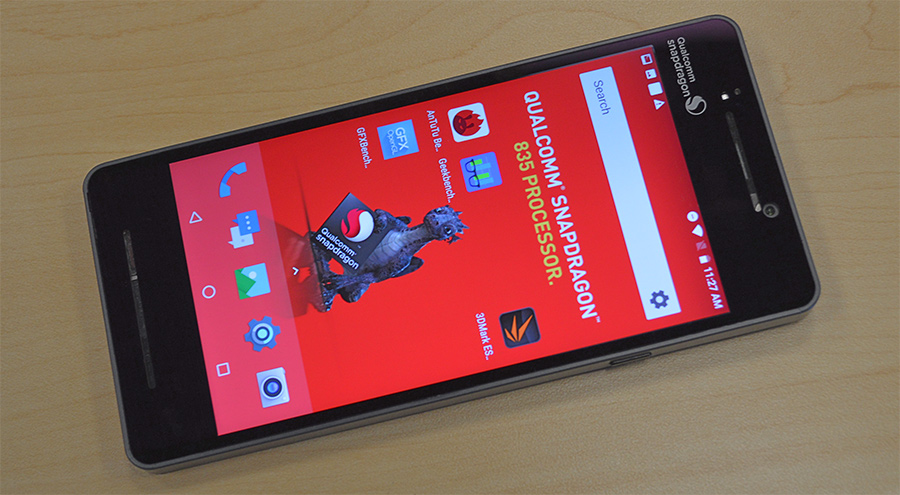The Qualcomm Snapdragon 835 Performance Preview
by Matt Humrick & Ryan Smith on March 22, 2017 4:30 AM EST- Posted in
- Smartphones
- Snapdragon
- Qualcomm
- Mobile
- SoCs
- Snapdragon 835
- Kryo

The Snapdragon 820 SoC was a significant milestone on Qualcomm’s roadmap. It was a solid improvement over the 808/810, delivering higher performance and efficiency, and became a commercial success, finding its way into the majority of flagship phones last year. More importantly, it heralded Qualcomm’s vision for mobile devices: heterogeneous computing. This meant new hardware—a much improved Hexagon 680 DSP that added single instruction, multiple data (SIMD) Hexagon Vector Extensions (HVX); Qualcomm’s first fully-custom 64-bit CPU core, Kryo, which focused on improving floating-point IPC; and an updated Adreno GPU with strong ALU performance—for enabling new software technologies and user experiences—artificial intelligence for smarter personal assistants, machine learning for object recognition, computational photography for better image and video quality, and new AR/VR experiences.
Snapdragon 835—now a part of Qualcomm’s Snapdragon Mobile Platform that includes all of the company’s mobile hardware and software—is an evolutionary product that builds on this vision. The greater than 3 billion transistor SoC is the first to use Samsung’s 10nm "10LPE" FinFET process, which reduces overall package size by 35% relative to Snapdragon 820. The new SoC’s CPU transplant and X16 LTE modem, which tops out at 1Gbps (Category 16) on the downlink, are the biggest changes, but most of the other blocks within the SoC have received at least minor updates too. For detailed information about all the changes and new features, you can read our Snapdragon 835 launch article.
| Qualcomm Snapdragon SoCs: Three Generations | |||
| SoC | Snapdragon 835 (MSM8998) |
Snapdragon 820 / 821 (MSM8996 / MSM8996 Pro) |
Snapdragon 810 (MSM8994) |
| CPU | 4x Kryo 280 Performance @ 2.45GHz 4x Kryo 280 Efficiency @ 1.90GHz |
2x Kryo @ 2.15GHz / 2.34GHz 2x Kryo @ 1.59GHz / 2.19GHz |
4x Cortex-A57 @ 2.00GHz 4x Cortex-A53 @ 1.50GHz |
| GPU | Adreno 540 @ 710MHz ? | Adreno 530 @ 624MHz / 653MHz | Adreno 430 @ 630MHz |
| Memory | 2x 32-bit @ 1866MHz LPDDR4x 29.9GB/s |
2x 32-bit @ 1866MHz LPDDR4 29.9GB/s |
2x 32-bit @ 1600MHz LPDDR4 25.6GB/s |
| ISP/Camera | Dual 14-bit Spectra 180 ISP 1x 32MP or 2x 16MP |
Dual 14-bit Spectra ISP 1x 25MP or 2x 13MP |
Dual 14-bit ISP 1x 21MP |
| Encode/Decode | 2160p30 (2160p60 decode), 1080p120 H.264 & H.265 |
2160p30 (2160p60 decode), 1080p120 H.264 & H.265 |
2160p30 (2160p60 decode), 1080p120 H.264 & H.265 |
| Integrated Modem | Snapdragon X16 LTE (Category 16/13) DL = 1000Mbps 3x20MHz CA, 256-QAM UL = 150Mbps 2x20MHz CA, 64-QAM |
Snapdragon X12 LTE (Category 12/13) DL = 600Mbps 3x20MHz CA, 256-QAM UL = 150Mbps 2x20MHz CA, 64-QAM |
Snapdragon X10 LTE (Category 9) DL = 450Mbps 3x20MHz CA, 64-QAM UL = 50Mbps 1x20MHz CA, 16-QAM |
| Mfc. Process | 10nm LPE | 14nm LPP | 20nm SoC |
In what has become an annual tradition going all the way back to Snapdragon 800, Qualcomm invited the media to its headquarters in San Diego for some feature demonstrations and limited testing using the company's Mobile Development Platform (MDP) devices. These are fully functional tablets or smartphones in a slightly oversized, utilitarian chassis used for hardware testing and software development. The MDP for Snapdragon 810 took the form of a tablet, while Snapdragon 820 came inside a large smartphone with a 6.2-inch display. This downsizing trend continues for Snapdragon 835, whose MDP/S is a smartphone with 6GB of RAM, a 5.5-inch 2560x1440 display, and a small 2850 mAh battery. The use of a smaller chassis is encouraging, because it has less mass and surface area to absorb and dissipate heat. This suggests a lower TDP for the 835, but we'll need to measure power consumption to be sure.
Because we only had a limited time for testing, we focused on running some basic CPU, GPU, and memory performance tests. Keep in mind that we were testing prototype hardware running pre-production software that resulted in a few hiccups. The condensed testing period also forced us to stray slightly from our usual testing methodology. Therefore, these numbers should be viewed as preliminary and could change by the time retail units begin shipping.












128 Comments
View All Comments
niva - Thursday, March 23, 2017 - link
You keep saying that it's not "real world" when earlier there were links provided that should be showing you that in the real world, today, multithread already matters, and having more real/virtual cores helps. This is all for the simplest and most used task for cell phones, web browsing, multi threading is quite useful. I'm fairly confident that if an Android manufacturer ran on hardware identical to the iPhone and outscored it across the board, you'll buy the iPhone anyways. Good for you but you're not helping in this discussion, just admit your apple fanboyism and bow out. Why do you even care about the SD 835?yankeeDDL - Thursday, March 23, 2017 - link
Let me be more specific then.Web browsing is a key part of mobile experience. In the Kraken, WebXPRT and JetStream the performance difference is stunning: Kraken: 2.4X faster; WebXPRT: 1.35X faster, JetStream: 2.4X faster.
Yes, the difference is not only due to HW, but also to code optimization. Still: damn!
In the GPU department: in GFXBench, the performance is on-par (when reported).
There's a noticeable advantage of the S835 in 3DMark (1.4X Overall), but in Basemark we loose again by nearly 2X.
Yes, the comparison is (a bit) apples to oranges, but one has to admit that for a brand new SoC it would make sense to expect an hands-down victory over a noticeably older phone.
BurntMyBacon - Thursday, March 23, 2017 - link
@yankeeDDL: "Still: damn!"Agreed, Apple has a massive advantage in javascript benchmarks. It is impossible to say how much (if any) of that is due to the SoC vs the software stack, but the advantage is undeniable.
It is not unexpected that the A10 would win in Basemark. The A10 is making use of a low level API (Metal) where the SD835 is using a high level API (OpenGL ES). Again, Apple's better software cohesion and better use of APIs benefits them here. Still, the difference is quite formidable and the SD835 actually looses to the Kirin 960 as well. It would seem that the Adreno 540 is not well suited to this workflow. Therefore, it is unlikely that use of Vulkan will suddenly propel them ahead, but the gap would be a lot smaller. By the time use of Vulkan becomes common place, A11(?) will be out, so it's really a moot point.
The GFXBench Car Chase ES 3.1 / Metal chart title suggests it should have an Apple data point (only user of "Metal"). It'll likely show the same thing as the basemark test given the disparate APIs, but I'm still curious (though not critical without further considerations) as to why it wasn't included.
The fact that you can't get an A10 without iOS and you can't get iOS on another companies SoC makes considerations about whether it is better than the android SoCs or not a tertiary concern and academic when compared to the overall platform experience. There are plenty of reasons not to like an iProduct. Performance isn't generally one of them.
tuxRoller - Friday, March 24, 2017 - link
If you take into account Qualcomm's optimized browser, the differences relative to the iPhone 7 change to:(% better than the sd835)
Kraken: 140 -> 106 webxprt: 35 -> -26 jetstream: 140 -> 92
I'm sure they could do more, but I'd be amazed if the remaining differences in kraken & jetsteam were mostly due to software.
Despoiler - Wednesday, March 22, 2017 - link
It's mostly the OS that Apple has superiority in. That's why they can use a dual core while Android phones are quad or octacore.grayson_carr - Saturday, March 25, 2017 - link
Isn't the A10 a quad core, or more correctly, a dual dual core big.LITTLE chip? Same as Snapdragon 820?akdj - Friday, March 31, 2017 - link
Yes, A10 is a quad-core big.LITTLE SoC, w/a 12-core GPU, I believe... as well, Apple on the 7+ added another GB of RAM = 3GB on an iOS phone, iPad 12.9" has 4GB -- but the iOS integration with the A10... as well, the last several generations of 'home brewed' ARM chips - and Apple's investments in silicon engineering from nVidia, Intel, AMD, Qualcomm, TI and others has paid dividends.That said, off Apple/AX chipsets for a second.... excellent 'first look' and factory/testing insight. That is very cool stuff!
I think, as geeks, and 'passionate' groups of faithful mobile phone OS folks amongst our population, folks who take this stuff more seriously than the Sunday sermon... we should all take a breath and remember that it's a 'chip preview'
Not an Android phone!
The issues with using the same chip on every device running Android --and every OEM 'skinning' their handset is a huge contributor to the varying performances; real world or objective bench tests. Like Windows as an OS on the desk and lap over the years, we've ALL had our 'Vista' moments. I'm an OS X/macOS user specifically because of 'vista and a curiosity about OS X in 2006 --- but again, I digress...
Qualcomm has built a chip able to be put in to every flagship other than iOS this year and 'compete' just fine. In the performance metrics all above are bickering about. But as an iPhone 7+ owner/lover (it's an excellent phone) -- my appreciation for the 835 goes well beyond its parity or near ...or exceeding metrics of CPU and GPU, they've built a gigabit LTE modem (who cares if you won't 'get that' - it's still gonna haul ass!) - incredible image processing and 'encryption/protection' with its iris scanning and biometric uses ...as well as the smaller node, the AIO model with all,parts of the 'brain' build in house --- IMHO, it's a 50-50 tie between chip engineering but I'm bias as an ambidextrous user since '07/'08 (iOS/Android) - I have always had one of each, the family is iOS and since switching everyone over, my workload has decreased 95%. It's vertical and horizontal integration and aggregation with macOS is, still to me, science fiction and for the family business... a God Send.
That said --- my S6 has an Exynos (sp?) processor, Note 4 was Qualcomm and, as I skip Android gens, my next will be a Qualcomm. I know as an iPhone 7+ owner I was delighted to learn that the model I bought has a Qualcomm modem, not the Intel;)
Special trip for you guys. Great write up and truly amazing to me ...I'm 45, born with the 8086 processor and the progress mankind has made in such a tiny package, which is high speed connected with exponentially more power than just a decade ago... in our pocket. We all need to remember between our friendly iOS/Android 'disputes' -- the special world we enjoy today specifically BECAUSE Apple and Google/Qualcomm/SnapDragons and their host of OEMs building what just a decade ago meant 110v, plugged in No mobility, significantly slower - even wired connectivity. None of the 'Millions' of free, $1, $5 & ten buck 'programs/software' then, apps, now - available on demand! Over 30 million song libraries, endless knowledge and tools, true magic is what I think the SD835 A10 Fusion and their predecessors are/were.
I'm old now, but not compared with the mountains I live in -- lucky enough to have spent the second ½ of my life quite literally watching these chips come to fruition ...I think it's the A10 when announced... it had/has over 3 billion transistors... and the SoC's the size of our fingernail!
Screw arguing. It's a competitive world and WE are the beneficiaries!
edlee - Wednesday, March 22, 2017 - link
the 835 has a 10% stronger gpu than a10, its just nuts that apple, not being a cpu designer at heart, can design a better cpu/soc that is years ahead of of what arm and qualcomm can produceBedfordTim - Wednesday, March 22, 2017 - link
There is a price/performance trade off with processors. Apple has chosen to make a much bigger processor which is why it is faster. Think Atom vs Core. One is slow but cheap and one is expensive and fast.Apple are not "years ahead". They have chosen to spend more on the processor.
Lord-Bryan - Wednesday, March 22, 2017 - link
"They have chosen to spend more on the processor"They also had 64bit arm cores 2 years before Qualcomm released theirs, And that's is why they are year's ahead in performance and power efficiency